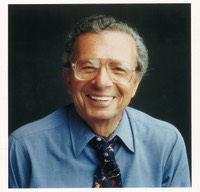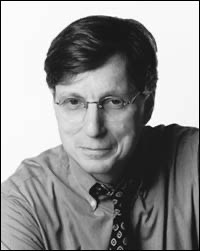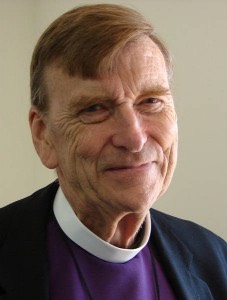From Publishers Weekly
The Passover story, told and retold by Jews throughout history, gets a cover-to-cover makeover this year. The Bronfman Haggadah by world-renowned philanthropist and Jewish leader Edgar M. Bronfman and illustrated by his wife, Jan Aronson (Rizzoli, Feb.), aims to fill a gap they believe is inherent in the traditional haggadah and create a narrative that is more engaging and relevant to modern readers.
The Bronfman Haggadah shares a vision of the exodus not so different from that of the Talmudic writers, who sought to encapsulate that historic period so that readers of subsequent generations could connect with and appreciate their ancestors’ experience, both in escaping bondage and in rejoicing in freedom. That, however, is where the similarities end.
Bronfman unabashedly removes whole portions of the conventional haggadah and inserts many of his own observations, poems, and interpretations (all in English). Instead in his own words he tells the background of the exodus, beginning from Moses’ birth through the decisive moment when God gave the Torah.
Perhaps the most significant revision is taking “the notion of a personal, supernatural, and anthropomorphic ‘god’” and replacing it “with one that…is understood as ‘energy–an energy that is both transcendent (beyond us) and immanent (within us),” Bronfman writes. He does include a close variation of the Mah Nishtana (The Four Questions) and Chad Gadya song, and embraces the four glasses of wine as well as the children’s favorite, the ritual of finding the afikomen, the hidden piece of the matzah. In this way, Bronfman hopes to convey the eternal messages of the timeless Passover story to children and adults alike.
Aronson’s beautiful watercolor illustrations adorn every page, sometimes with subtle implications, sometimes more explicitly, but in a way certain to capture the interest of even reluctant seder participants. Bright colors, sharp lines and shapes, and vivid portrayals of seder-related events bring the age-old story to life.While traditional readers may balk at Bronfman’s liberties, seder participants with less Jewish background or those seeking a more contemporary angle might better relate to and appreciate the modifications.
----------------------------------
INTERFAITHFAMILY: A NEW
PASSOVER HAGGADAH FROM
EDGAR BRONFMAN
by Benjamin Maron, excerpted from a longer post for the InterfaithFamily Network Blog.
…Keeping with the themes of openness, new ideas, and inclusion, Bronfman has written a new Passover Haggadah, the book used as a guide for the ritual dinner, theseder.
His own family seders are large and celebratory affairs and include intermarried family members and friends old and new who are welcomed to enjoy the annual feast together.
Well-chosen readings from luminaries, including abolitionist Frederick Douglass and poet Marge Piercy, highlight the story of slavery and freedom. Bronfman’s creative and interactive approach is a story for all ages, in which readers assume a character in the Exodus journey.
It also diverts from the traditional Haggadah in a way that is extremely welcoming to interfaith families. “I decided to open the door to Elijah at the beginning of the meal instead of at the end. I always found it slightly odd that Elijah was invited to the table after the meal. My wife, Jan, and I both believe it is before this joyous feast begins that we ought to invite the stranger into our homes,” he writes in the Haggadah.
In Bronfman’s view, Elijah represents a redeemed world — a world free of racism, slavery, cruelty, poverty and greed. Elijah also represents the hungry stranger. This gesture reminds us to open the doors of our hearts to those in need during this holiday season and the rest of the year.
Inviting and inclusive, and with illustrations by Bronfman’s wife, Jan Aronson, it looks like a nice new alternative for families who want to share the storytelling and keep the seder to English.
What do you think? Is this a Haggadah your family will try out this Passover?
----------------------------------
JEWISH TELEGRAPH AGENCY:
FOR AMERICAN JEWS WHO
DON’T KNOW HEBREW
by Penny Schwartz excerpted from a longer article for the Jewish Telegraphic Agency
“The Bronfman Haggadah” is written entirely in English. Bronfman said it’s to appeal to most American Jews, who do not know Hebrew. The reading takes about an hourand a-half. Unlike the traditional haggadah, Bronfman includes Moses, who he holds as a role model of a leader who asks questions and disrupts the status quo. But all the characters of the Exodus, including God, are represented as metaphor and not historical facts, he wrote.
Welcoming Elijah the prophet earlier in the seder underscores the Jewish value of welcoming in strangers, Bronfman said.
New words to the popular song “Dayenu” express gratitude for establishing a homeland in Israel. Bronfman ends the seder with a call for spiritual peace in Jerusalem among Israelis and Palestinians, Jews and Arabs, and all warring peoples.
Notably, Bronfman expanded the narrative of the traditional haggadah to include the giving of the Ten Commandments at Mount Sinai. While the foundation of Jewish law is the theme of Shavuot, he acknowledged that most Jews are unaware of the holiday that follows Passover.
“Freedom doesn’t mean anything without the responsibility of law,” Bronfman told JTA. “To be free is a privilege we too often take for granted.”
Arsonson, who has fond memories of Passover seders growing up in New Orleans, spent nearly a year working on the illustrations for the “Bronfman Haggadah,” determined to avoid clichéd images. To keep the images fresh — and to entertain youngsters — she changed up the artistic styles from one page to another — some are realistic, others abstract or geometric — and also varies the mood and colors. A biblical map of the Exodus depicts the possible routes traveled by the Israelites.
For the Ten Plagues, Aronson drew a large singing insect that will capture the attention of children. Miriam’s tambourine is vibrantly colored with long flowing ribbons that complement the joy described in the narrative as the Israelites escape bondage.
-----------------------------------
HADASSAH MAGAZINE:
A BEAUTIFULLY CRAFTED BOOK
by Zelda Shluker for Hadassah Magazine
This is the first Haggada that Edgar M. Bronfman—businessman, philanthropist, communal leader, author—has written, and it is personal. Here are some of the elements you won’t find in these pages: Hebrew and traditional blessings.
It is more illuminating to note what is included: A lot of participation from those sitting around the Seder table, with assigned readings for leader and celebrants. An “Exodus Script” narrates Moses’ story.
Including the Counting of the Omer in the Haggada as the lead-up to Shavuot, Bronfman—who early on in the text uses the word “energy” to replace “God”—writes that without the law, the liberation from Egypt would have no meaning. “Omer connects liberty and law, reminding us that without responsibility, freedom leads to chaos,” he declares.
Bronfman also includes his desire for peace in his version of “Dayenu”: “And if we deliver peace between ourselves, the Palestinians, and our Arab neighbors…that will be enough!”
Indeed, his vision for Next Year in Jerusalem is to “commit ourselves to supporting every idea, every effort, and every carefully crafted plan that seeks to lead Palestinians and Israelis, Jews and Arabs—indeed all of the world’s clashing people—out of the dark and narrow straits of fear and violence, out of the strictures of hatred and war, and into the spiritual Jerusalem—the true Promised Land—an open and peaceful place flowing with the milk and honey of justice, compassion, and freedom for all.”
Though not everyone will be comfortable with this Haggada on their table, this beautifully crafted book has one notable feature that all can agree on—the delightful illustrations by Jan Aronson, Bronfman’s wife and collaborator. Patterns that frame the pages are derived from ancient Egyptian tiles and relief sculpture, Greek and Roman vase and decorative painting and African textiles. Other images are bold, bright and naturalistic—a full-page snake, grasshopper, mountains, forests and the Burning Bush.
-----------------------------------
RABBI ANGELA BUCHDAHL: LIKE THE SEDER ITSELF, IT ENGAGES THE SENSES
“The Bronfman Haggadah exemplifies hiddur mitzvah with its elevation and beautification of the remembrance of our Exodus from Egypt. The Haggadah teaches in many forms, inviting conversation and inspiring compassion. With stunning watercolor illustrations by Jan Aronson, the Bronfman Haggadah, like the Seder itself, engages the senses. Edgar Bronfman wanted this Haggadah to inspire Jewish pride and understanding, and to contribute to the Jewish renaissance. This masterwork is only the most recent contribution Edgar Bronfman has made to the renaissance of Jewish life.”
-Rabbi Angela Buchdahl, Central Synagogue
-----------------------------------
JEWISH BOOK WORLD: A DISTINCTIVE AND HIGHLY PERSONAL HAGGADAH
Review in Jewish Book World by Maron L. Waxman
“For many years, Edgar Bronfman, the philanthropist, and his wife, Jan Aronson, the artist known for her landscapes and portraits, sought to make their seders not only a time to celebrate but also to teach young people about Judaism and the importance of Jewish pride and commitment. Each year they drew their haggadah from various sources, but they were never truly satisfied with the result. Finally Edgar Bronfman decided to compose his own haggadah, and he asked Jan Aronson to illustrate it. Together they have created a distinctive and highly personal haggadah.
-----------------------------------
DANIEL HANDLER: CLEAR-HEADED BUT ALLOWS FOR ARGUMENT
“The Bronfman Haggadah has everything I want in a seder guest. It’s clear-headed but allows for argument. It’s straightforward but has a flair for the dramatic. It’s colorful but not tacky, opinionated but not dogmatic, and it’s not so long-winded that the soup gets cold. Dive in!”
—Daniel Handler is an author, screenwriter and accordionist. He is best known for his work under the pen name Lemony Snicket.
--------------------
LILLITH: ARTIST JAN ARONSON HAS AN UNCONVENTIONAL STREAK
QUOTE
The following is an article about Jan Aronson in the Spring 2013 issue of Lillith Magazine by Ruth Andrew Ellenson.
“A petite woman with a penchant to surprise you, artist Jan Aronson has an unconventional streak that’s immediately apparent. A bolt of bright red is woven into the auburn locks framing her face, Susan Sontag-like. “The color is called ‘Cherry Bomb’,” she confides.
“Aronson’s bold use of color is apparent throughout the original, imaginative illustrations she has made for The Bronfman Haggadah, a new book she has co-created with her husband, philanthropist Edgar M. Bronfman. Together for 24 years, and married for 19, this book marks the first time she and her husband have worked together. He wrote the text, she handled the illustrations. They employ design motifs from Egyptian, Greek, Roman and African cultures, as well as images not usually found in the guide to the seder: biblical maps, feathers as symbols of flight and freedom, vividly detailed mosquitoes and frogs. Among the most striking: a tiny basket carrying baby Moses virtually lost in the vast, lush landscape of the Nile. “I like the things you don’t expect,” she explains. “As an illustrator you want to challenge the imagination and surprise people.”
-----------------------------------
RABBI HAROLD KUSHNER: AN ESTHETIC TREAT AND AN INSPIRATION FOR ALL
“The Bronfman Haggadah is an esthetic treat and an inspiration for all who would aspire to create a personal haggadah for their family use.”
-Rabbi Harold Kushner, author of “When Bad Things Happen to Good People,” served as the congregational rabbi for Temple of Israel of Natick, Massachusetts for 24 years. His most recent book, “Overcoming Life’s Disappointments,” was released in 2006.
-----------------------------------
TOBY KAHN: A NEW DIMENSION TO THE EXPERIENCE OF PASSOVER
“Edgar Bronfman and Jan Aronson have brought together their verbal and visual modes of understanding to create an extraordinary haggadah. The images transform and illuminate our journey from slavery to freedom, while the text makes each participant feel part of the narrative. Together, they offer a new dimension to the experience of Passover. A beautiful work.”
—Toby Kahn, painter and sculptor.
--------------------
MILTON ESTEROW: ILLUSTRATED WITH SKILL AND IMAGINATION
“Jan Aronson has illustrated Edgar Bronfman’s text with skill and imagination to delight everyone at the Passover seder table.”
–-Milton Esterow, editor and publisher of ArtNews
--------------------
ARI L. GOLDMAN: A HAGGADAH THAT WILL ENRICH EVERY SEDER TABLE
“The Passover haggadah is not a static document but a living one that must be refashioned for every generation. “Tell the children,” the Bible commands. The new
Bronfman Haggadah has more than fulfilled that commandment with its wise commentaries, powerful poetry and stunning watercolors. This is a haggadah that will enrich every seder table.
– Ari L. Goldman is a professor of journalism at the Columbia University Graduate School of Journalism and the author of three books, including the best-selling The Search for God at Harvard, Being Jewish: The Spiritual and Cultural Practice of Judaism Today (2000) and a memoir, Living a Year of Kaddish (2003).
--------------------
JOHN SHELBY SPONG: A BOOK I SHALL TREASURE
“The magnificent Bronfman Haggadah combines first rate
biblical scholarship, keen theological sensitivity and penetrating transcendent insights. It takes the well known and treasured Jewish story and traces how it evolved over the centuries into being a deeply human story. Jan Aronson’s artistic contributions to this Haggadah serve to draw the reader beyond the literal words of the text into the universality of their meaning. It is a book I shall treasure.”
–John Shelby Spong, author, Liberating the Gospels: Reading the Bible with Jewish Eyes



